Audrey Crews has captured global attention as a trailblazer at the intersection of neuroscience, artificial intelligence (AI), and robotics. Paralyzed for two decades after a devastating spinal injury, she recently became the first woman in the world to control a computer directly with her mind using Elon Musk’s Neuralink brain-computer interface. Her journey from paralysis to “telepathic” technology user is not only a personal triumph but a milestone that foreshadows transformative impacts on the future of AI and robotics.
Background: Two Decades of Paralysis and Hope
In 2005, at just 16 years old, Audrey Crews suffered a severe car accident that damaged her C4 and C5 vertebrae, leaving her quadriplegic. For 20 years, she had no movement below the neck, relying on caregivers for every basic task. Despite this, Audrey remained mentally sharp and determined. When Neuralink – a neurotechnology company founded by Elon Musk in 2016 – offered a ray of hope through its brain implant trial, Audrey volunteered with a vision of regaining some independence. In July 2025, at age 35, she underwent brain surgery at the University of Miami Health Center to receive Neuralink’s experimental N1 implant. Little did she know, her courage would soon make history in the tech world.
A Historic Neuralink Implant and First Achievements
The Neuralink surgery involved drilling a small hole in Audrey’s skull and implanting a coin-sized brain chip beneath it. 128 ultra-thin threads (each thinner than a human hair) were robotically inserted into her brain’s motor cortex, the area controlling voluntary movement. The procedure was delicate and high-tech – a robot assisted the neurosurgeons to place each thread with micrometer precision. Audrey praised the surgical team as “awesome” and “some of the sweetest people I’ve ever met,” noting they treated her like a VIP throughout the process.
Only a week after surgery, the implanted brain-computer interface (BCI) was activated – and the results stunned the world. Despite still being fully paralyzed, Audrey was now able to interact with a laptop using only her thoughts. She demonstrated several groundbreaking feats that she hadn’t done in decades:
- Writing her name: Audrey “scribbled” the name “Audrey” on a digital notepad using her mind, the first time she had written in 20 years. She posted a photo of this purple handwritten signature on X (formerly Twitter) with the excited caption, “I tried writing my name for the first time in 20 years. I’m working on it. Lol.”
- Controlling a cursor and games: By imagining moving her hand, she could move a computer cursor. She even played simple computer games entirely via thought, an impossible task for her before.
- Drawing and doodling: Audrey mentally sketched shapes and pictures on the screen. In one update, she shared a digital page showing her name alongside a red heart, a bird, a smiling face, and a slice of pizza – all drawn “with her mind”. “Here are some more of my doodles! I’m taking requests. Lol,” she wrote, describing the experience of drawing by thought as “just a normal day using telepathy.”
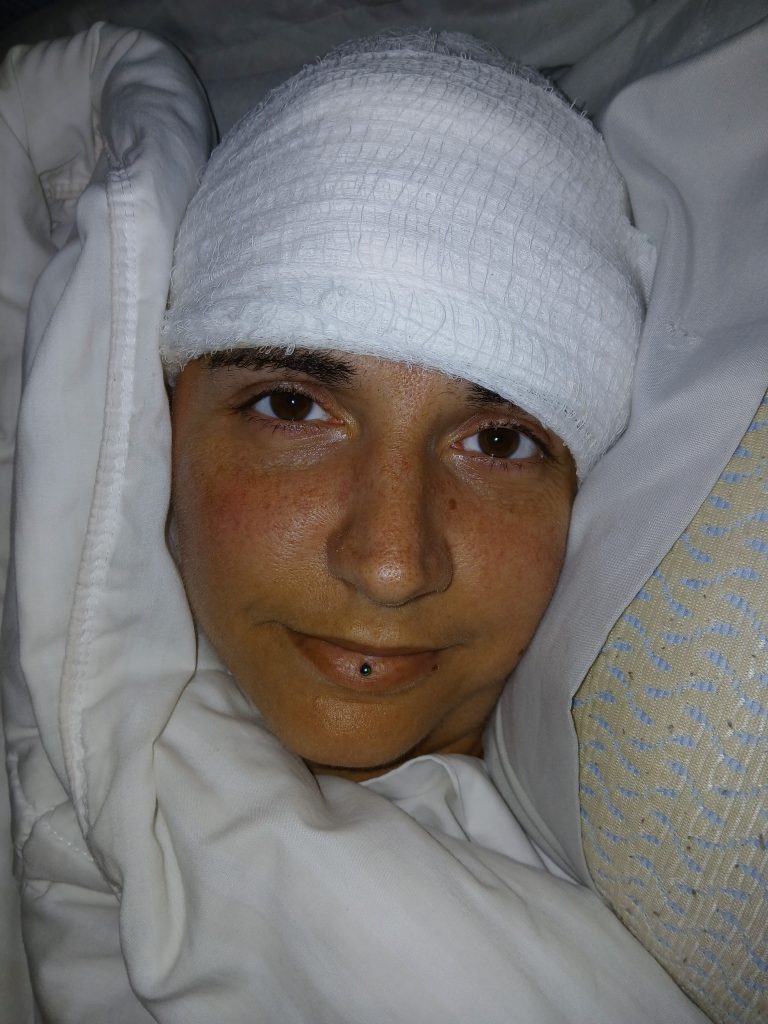
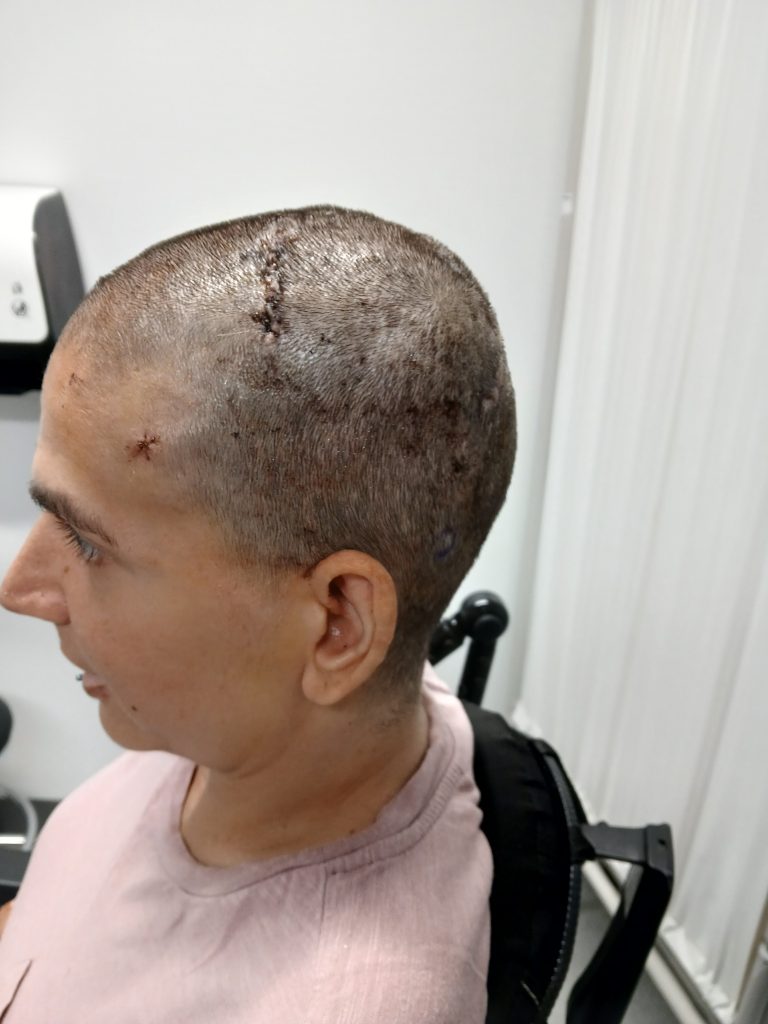
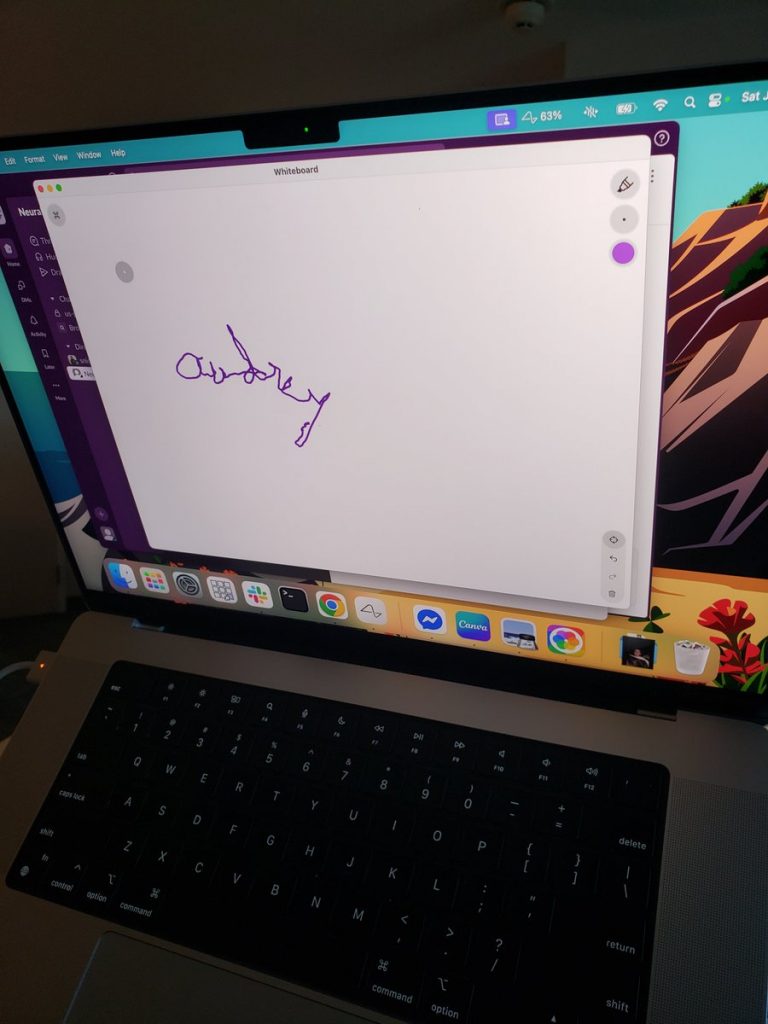
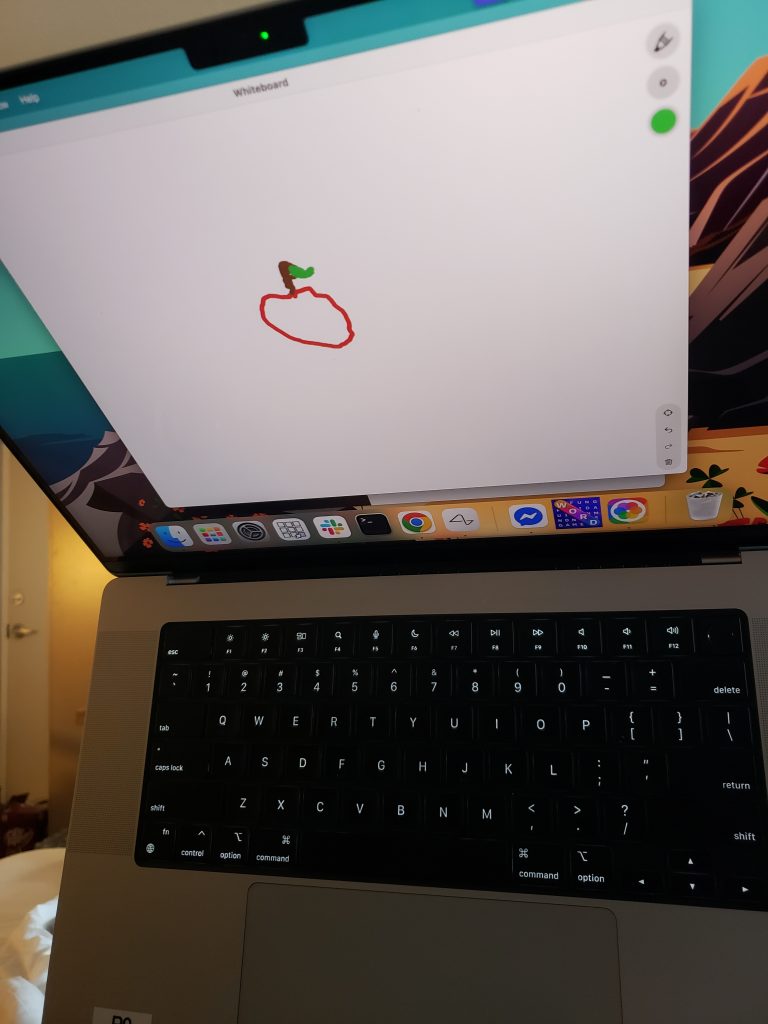
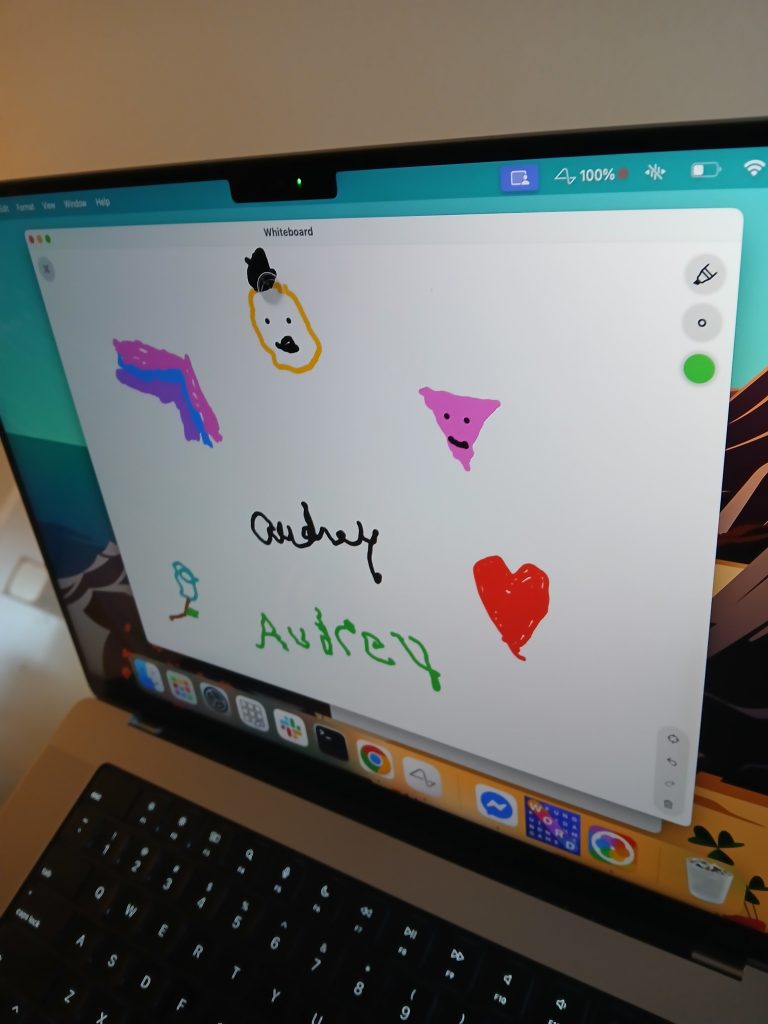
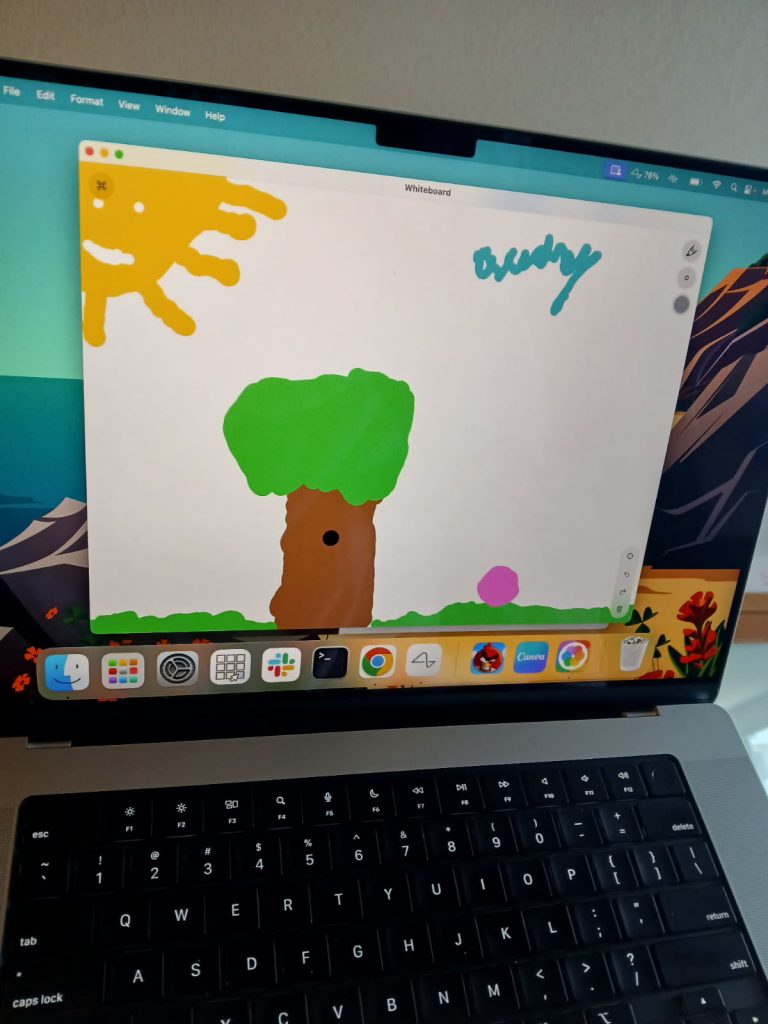

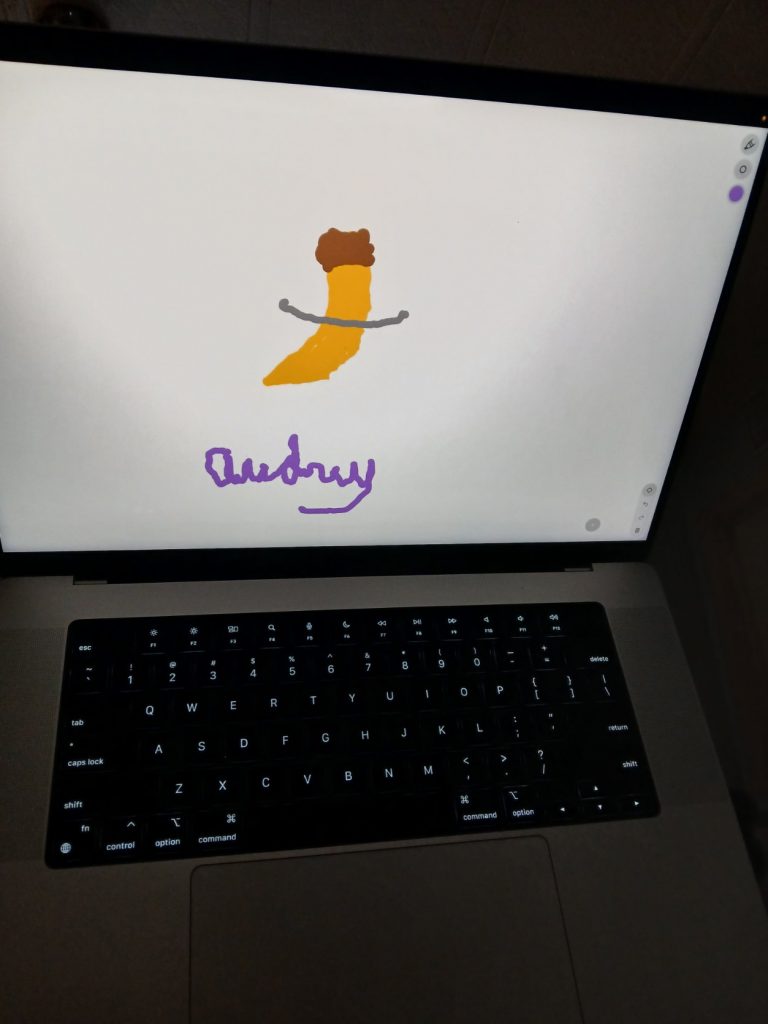
These achievements, made without moving a single muscle, marked Audrey as a pioneer. She became the first female patient of Neuralink (known as “Patient P9” in the trial) and the public face of a new kind of human-machine interaction. Elon Musk himself amplified her story, marveling that, “She is controlling her computer just by thinking. Most people don’t realize this is possible.” The video clip of Audrey’s mind-controlled writing went viral, garnering over 2 million views within days. After two decades of being unable to use her arms, Audrey’s mind now did the typing and drawing – a groundbreaking feat in assistive technology.
Bridging the Human Mind with AI
At the heart of Audrey’s new abilities is an AI-driven decoding system that translates her neural activity into digital commands. The Neuralink implant works by reading the electrical signals her brain generates when she thinks about moving. These signals are then sent wirelessly (via a Bluetooth-like connection) to an external computer. Advanced AI algorithms interpret the patterns, allowing Audrey’s thoughts to move a cursor or draw shapes on screen in real time. Essentially, the chip and its software serve as an AI-powered mediator between her mind and the computer, bypassing the broken spinal connection that prevented her from moving for years.
Audrey herself explained the process in simple terms on social media: “Imagine your pointer finger is the left click and the cursor movement is with your wrist – without physically doing it.” By merely intending those motions, she could click and move on the screen. This direct translation of thought to action is often likened to “telepathy,” and in Audrey’s case it truly appears that way.
The implications for AI are profound. Neural interfaces like Audrey’s rely on machine learning to discern user intent from complex brainwave data. Each successful use by Audrey helps refine these AI models, improving accuracy for her and future users. Digital autonomy – the ability to use computers through thought – could dramatically improve quality of life for people with paralysis. With AI decoding their intentions, individuals who cannot speak or move could communicate, work, or create art on a computer just as anyone else can. Audrey’s success shows that the technology is no longer theoretical: the human brain can directly interface with AI systems to overcome physical limitations.
Perhaps just as importantly, Audrey’s case is building public confidence in such AI-driven medical devices. She has been candid about the experience, sharing videos and notes about her progress. By demystifying the BCI technology, she helps the wider community appreciate how AI can be harnessed in compassionate ways. Her story demonstrates that AI is not just about autonomous cars or chatbots – it can be intimately woven with human lives to restore capabilities and “unlock new dimensions of human potential,” as Neuralink’s mission states.
Opening New Frontiers in Robotics and BCIs
Audrey Crews’ achievement also resonates strongly in the robotics world. The essence of a brain-computer interface is to let the mind control external devices – and that can include robotic limbs and tools. Neuralink reports that in its ongoing trials, patients like Audrey are “using Neuralink devices to control computers and robotic arms with their thoughts.” This means the same technology enabling Audrey to sketch digitally could one day allow someone to control a prosthetic arm or even a robot assistant purely via brain signals.
In Audrey’s case, the immediate “robot” under her command was the computer cursor. But the general principle extends to any connected machine. For people with paralysis, this could be life-changing. A mind-controlled wheelchair or robotic exoskeleton, for example, might restore a degree of physical mobility. A robotic arm mounted on a wheelchair could be directed by thought to pick up objects or feed the person. Audrey’s successful trial is a proof-of-concept for these possibilities – a first step toward patients manipulating the physical world through robotic proxies controlled by the brain.
The procedure that gave Audrey her implant also showcased cutting-edge robotics. Neuralink’s implantation is done with the assistance of the R1 robot, a neurosurgical robot designed to insert the fine electrode threads reliably into the brain. This robotic surgeon can perform movements far steadier than a human hand, which is crucial when dealing with fragile brain tissue. The use of robotic surgery in Audrey’s case minimized risk and precisely placed the implant. It’s a prime example of robotics enhancing medical outcomes and enabling interventions (like high-density neural implants) that would be extremely difficult manually.
Audrey’s new abilities are thus the result of a synergy between AI and robotics: AI decoding her thoughts, and robotic systems executing or enabling actions based on those thoughts. Each time Audrey moves the cursor with her mind, one can envision a future scenario of a robotic arm moving correspondingly. In fact, Neuralink’s long-term goals explicitly include:
- “Telepathy” – allowing users with paralysis to control computers, phones, or robots directly via neural signals (the very goal Audrey is now beginning to fulfill).
- “Blindsight” – future implants to bypass damaged optic nerves and restore vision by sending signals from a camera directly to the visual cortex.
- “Deep” (brain stimulation) – treating neurological disorders like Parkinson’s or epilepsy via targeted neural modulation.
Audrey’s successful implant mainly addresses the telepathy goal, but it paves the way for the others by proving the implant’s viability. Five to nine human patients have received Neuralink chips so far, each expanding what’s possible. Audrey’s role as the first female participant and one of the most public-facing pioneers is inspiring more volunteers and investment into these technologies. Every doodle she draws or message she types with her mind underscores how brain-controlled robotics can move from science fiction to everyday reality.
Impact and Recognition in the Tech Community
The technological community and general public have hailed Audrey Crews’ progress as a breakthrough moment for neurotechnology. Her achievement is frequently compared to other historic medical-robotic milestones, such as the first successful use of a prosthetic limb controlled by neural signals or the first cochlear implant restoring hearing. Like those innovations, Audrey’s mind-writing demonstration shows a fundamental new capability: that purely thought-driven computer control is not only possible, but it’s happening now.
Media coverage worldwide celebrated Audrey’s first “telepathic signature” as a symbol of hope for millions living with paralysis. After her story went viral on X, thousands of well-wishers and observers responded with astonishment and encouragement. Elon Musk’s public confirmation of her feat lent further credibility and shined a spotlight on the rapid progress of BCIs.
Researchers in AI and robotics see Audrey’s case as validation of years of work in labs. It demonstrates that high-bandwidth brain interfaces can work in real life outside of controlled laboratory settings. As Engineering and Technology Magazine noted, Neuralink’s trial entering human phase with Audrey indicates the field is at a “pivotal moment in medical neurotechnology.” What was once experimental — monkeys moving cursors or pigs with implanted sensors — has graduated to human patients achieving functional outcomes. This success will likely accelerate competition and development in the BCI space. Competing research teams and companies (some backed by tech giants) are now more likely to push forward with their own neural interface projects, galvanized by Audrey’s tangible results.
Audrey’s journey also highlights the importance of user experience in advanced tech. As one of the first users, she provides invaluable feedback: she tweets about the nuances of the device, shares her learning process (writing by thought is like training a new skill), and even engages in a bit of humor. Her openness helps engineers refine both the hardware and software. For instance, if the cursor lags or a thread disconnects (an issue that the first male patient experienced months after his implant), early users like Audrey can help pinpoint these problems and improve the next iterations. In many ways, Audrey has become a collaborator in the development of brain-computer interfaces, not just a test subject. Her very public success and continued practice (she’s been posting new drawings and updates regularly) build confidence that these devices can be used consistently in daily life, not only in a one-off lab demo.
Notably, Audrey’s achievement arrives amid increasing convergence of AI and robotics in assisting people with disabilities. Eye-tracking systems, voice assistants, and robotics have already improved accessibility; Audrey’s case takes it a leap further by connecting the mind directly to machines. It’s a profound illustration of technology empowering individuals – turning what was once considered a permanent “lock-in” of the body into a new form of freedom. As Audrey succinctly put it after using the Neuralink, “I feel liberated.” Her experience is reshaping how society views severe paralysis: not as an absolute barrier, but as a challenge that cutting-edge tech is increasingly able to surmount.
Audrey Crews’ Vision and Ongoing Journey
For Audrey, these early victories are just the beginning. Far from being content with writing her name, she is already envisioning broader uses for her newfound tech interface. “I’ll be able to control more electronic devices in the near future,” she noted, indicating plans to try things like smart home controls or other gadgets as her proficiency grows. Each week of practice could bring new milestones – perhaps operating a phone or designing artwork – all via her Neuralink link. She quipped that she’s “taking requests” for what to draw next, highlighting her playful engagement with the technology.
Audrey also sees herself as an advocate and storyteller. In response to public interest, she expressed an eagerness to share her journey in depth. “Hopefully [I’ll] write a book about my journey. I’ve been a quadriplegic since the age of 16 so I have lots to tell,” she posted. Such a memoir would not only chronicle her personal story of resilience but also educate readers about BCIs and inspire others facing similar hardships. By planning to document her experience, Audrey signals her commitment to advancing the field – not just as a user, but as a communicator. She has effectively become an ambassador for Neuralink’s technology and, more broadly, for human-AI symbiosis.
Indeed, Audrey’s vision for the future aligns with the optimistic outlook of the Neuralink project: a world where people with disabilities can participate in the digital and physical world on equal footing, and where eventually even those without disabilities might extend their capabilities. Elon Musk has often cited an end goal of “merging humans with AI.” In practical terms, this could mean implants that boost memory, enable telepathic communication between people, or allow control of advanced robotics and computers at the speed of thought. Audrey’s success has made such musings far less abstract. She herself is living proof that a brain interface can restore lost function – a necessary first step toward any larger cognitive enhancement. While she is focused on regaining autonomy rather than sci-fi superpowers, Audrey welcomes the possibilities her case unveils. “The BCI lets me control my computer using my mind… It’s strictly for telepathy only [for now],” she clarified, “We are still in Miami but I’ll be home soon and we’ll post more vids explaining the process in more detail.” Every video she shares, every progress update, is helping to normalize and refine brain-interface technology for the future.
Audrey’s positive experience also provides momentum for Neuralink’s ongoing trials. The U.S. FDA granted approval for these first human trials in 2023, and Neuralink has since implanted the device in nine patients so far. With her and others demonstrating success, Neuralink could seek broader clinical trials and regulatory approvals to eventually offer the BCI to larger populations. Musk has even suggested that, if all goes well, neural implants could become as routine as LASIK eye surgery in the coming years. That remains speculative, but Audrey’s progress will surely factor into how quickly society and regulators gain trust in the safety and value of such devices. She has shown that, with proper care, a person can live with a brain implant and benefit enormously from it – a narrative that data and safety reports alone could never convey as powerfully.
Of course, Audrey is aware (as are the scientists) that this frontier tech comes with challenges. The implant does not restore her ability to walk or heal her injury – “it will not allow me to regain movement,” she reminds curious followers, tempering expectations. It also raises new questions about long-term implant durability, data privacy, and ethics. If minds can be read by machines, even for benevolent purposes, how do we protect users’ mental privacy? How do we safeguard the systems from hacking or malfunction? These are questions researchers are actively grappling with. Audrey’s role in this unfolding narrative is crucial: as one of the first to live with a high-bandwidth BCI, her feedback on any side effects or vulnerabilities will guide how developers strengthen the technology and how policymakers might craft regulations. In a very real sense, her courage to go first is a direct contribution to making future AI/robotic integrations safer and more effective for everyone.
Future Implications for AI and Robotics
Audrey Crews’ triumph is not an isolated anecdote, but rather a harbinger of a new era in AI and robotics integration. By proving that a human brain can communicate with a computer to perform complex tasks (like writing and drawing) unaided, she has erased lingering doubts about feasibility. The focus now shifts to scalability and innovation: how broadly and creatively can this capability be applied?
In the near future, advances inspired by Audrey’s case may enable a host of applications:
- Assistive Robotics: Mind-controlled wheelchairs, prosthetic arms, or service robots for those with paralysis or limb differences. Audrey’s success controlling a 2D cursor today could translate to controlling a robotic limb in 3D space tomorrow, giving users the ability to feed themselves, drive a wheelchair, or handle objects via thought.
- Communication for the Voiceless: Individuals who cannot speak (due to conditions like ALS or brainstem stroke) might use BCIs to type out messages or control speech-generating devices at conversation speed. Neuralink’s device aims to “help restore communication for individuals with severe speech impairment”, as the company noted when it received FDA permission for trials. Audrey’s mind-typing is the first step toward that goal.
- Enhanced Learning and Memory: In able-bodied users down the road, similar implants could potentially interface with memory or cognitive centers. There is speculation, supported by Musk’s statements, that this tech could improve memory recall or even allow memory recording and replay – essentially an AI extension of the human brain. While this is further off, the principle is the same one Audrey has showcased: the brain’s neural code can be read and written by computers.
- Human-AI “Symbiosis”: By integrating AI directly with our neural processes, humans could interact with AI agents more intuitively. Instead of keyboards or voice commands, future interfaces might let people query AI just by thinking, or receive AI guidance as internal signals. Musk describes this ultimate vision as preventing humans from being left behind by AI by in effect joining with AI. Audrey’s implant is a primitive form of this union – a direct data link between mind and machine – that could evolve in sophistication.
- New Research in Neuroscience: Every bit of data from users like Audrey helps neuroscientists understand brain organization and plasticity. Already, Audrey has had to train her brain in subtle ways to improve her mind-writing; her brain is adapting to the device and vice versa. Studying this adaptation can yield insights into how flexible the adult brain is and how it can learn to control external devices as if they were part of the body schema. This knowledge might inform the design of better AI decoding algorithms and new rehabilitation therapies for stroke or injury.
The road ahead is not without hurdles. Ensuring that the implants remain safe, reliable, and secure is paramount before widespread adoption. Early trials, including the one Audrey is in, will need to demonstrate that users can live with these devices long-term without serious risks. There will also be the task of making the technology more affordable and accessible if it is to help large numbers of people (currently, such a procedure is extremely specialized). Yet, the momentum generated by Audrey’s story is driving these conversations forward. It has prompted discussions not just in scientific circles but in society about what it means to blend human capability with AI and robotics.
Perhaps the most immediate impact of Audrey Crews’ accomplishment is motivational. It provides a real-world success story that engineers, investors, and potential volunteers can point to. It is easier to secure funding or approval for bold AI-robotics projects when you can cite “Audrey Crews did X, Y, and Z using this approach.” In this way, her contribution is multiplying: it’s influencing the trajectory of research and innovation. Tech companies beyond Neuralink are likely taking notice. As one tech analyst predicted, if Neuralink continues to show success with patients like Audrey, we can expect major players like Apple, Microsoft, or Meta to enter the brain-computer interface space within a few years. The age of mind-powered machines appears to be on the horizon, and Audrey is standing at its forefront.
In summary, Audrey Crews’ journey from tragedy to triumph embodies the incredible possibilities unlocked when human determination meets advanced AI and robotics. She has expanded the frontier of human potential, showing that even when the body is immobilized, the mind can reach out and control the world through technology. Her contributions – as a user, innovator, and advocate – are already influencing the current state of AI and robotics, and will undoubtedly shape their future. As we watch Audrey draw a heart with her thoughts or sign her own name after 20 years, we are witnessing more than a singular achievement; we are witnessing the dawn of a new chapter in human-tech coevolution. In Audrey’s own celebratory words, describing her nightly practice with the Neuralink, it’s “just a normal day using telepathy” – a normal day that once seemed impossible, now made real. And for the AI and robotics community, it is a powerful reminder that the mind truly knows no bounds when paired with the right technology.
References
- Crews, Audrey. Audrey Crews (@NeuraNova9) on X.
- Knutsson, Kurt. Woman Uses Neuralink to Write Name with Her Mind. CyberGuy, 31 July 2025.
- “Paralysed Woman Controls Computer with Her Mind Using Elon Musk’s Neuralink Brain Chip.” The News Chronicle, 29 July 2025.
- Khollam, Aamir. Neuralink Helps Paralysed Woman Write Her Name After 20 Years. Interesting Engineering, 28 July 2025.
- “Paralysed Neuralink Patient Writes Name Using Her Thoughts, Elon Musk Responds.” NDTV, 30 July 2025.
- Panda, Anshul. Who Is Audrey Crews? Woman Paralyzed for 20 Years Starts Controlling Computer with Neuralink Brain Implant. International Business Times, 28 July 2025.
- Vincent, James. Neuralink Patient Says She Can Control a Computer with Her Mind. The Verge, 29 July 2025.
- Timsit, Annabelle. Neuralink’s First Patient Can Control a Computer with Her Thoughts. The Washington Post, 29 July 2025.
- Sheftalovich, Zoya. Neuralink’s First Patient Says She Can Control a Computer with Her Brain. Politico, 29 July 2025.
- Vincent, James. Neuralink’s First Patient Demonstrates How She Uses Brain Implant to Control a Computer. The Verge, 30 July 2025.
- “Paralysed Woman Writes Her Name Using Thought in Neuralink Clinical Trial.” Engineering & Technology, 29 July 2025.
- Neuralink. PRIME Study. 2025.
- University of Miami Health System. Neuralink Brain Implant Trial Participant Achieves Digital Autonomy. 31 July 2025.
Get the URCA Newsletter
Subscribe to receive updates, stories, and insights from the Universal Robot Consortium Advocates — news on ethical robotics, AI, and technology in action.

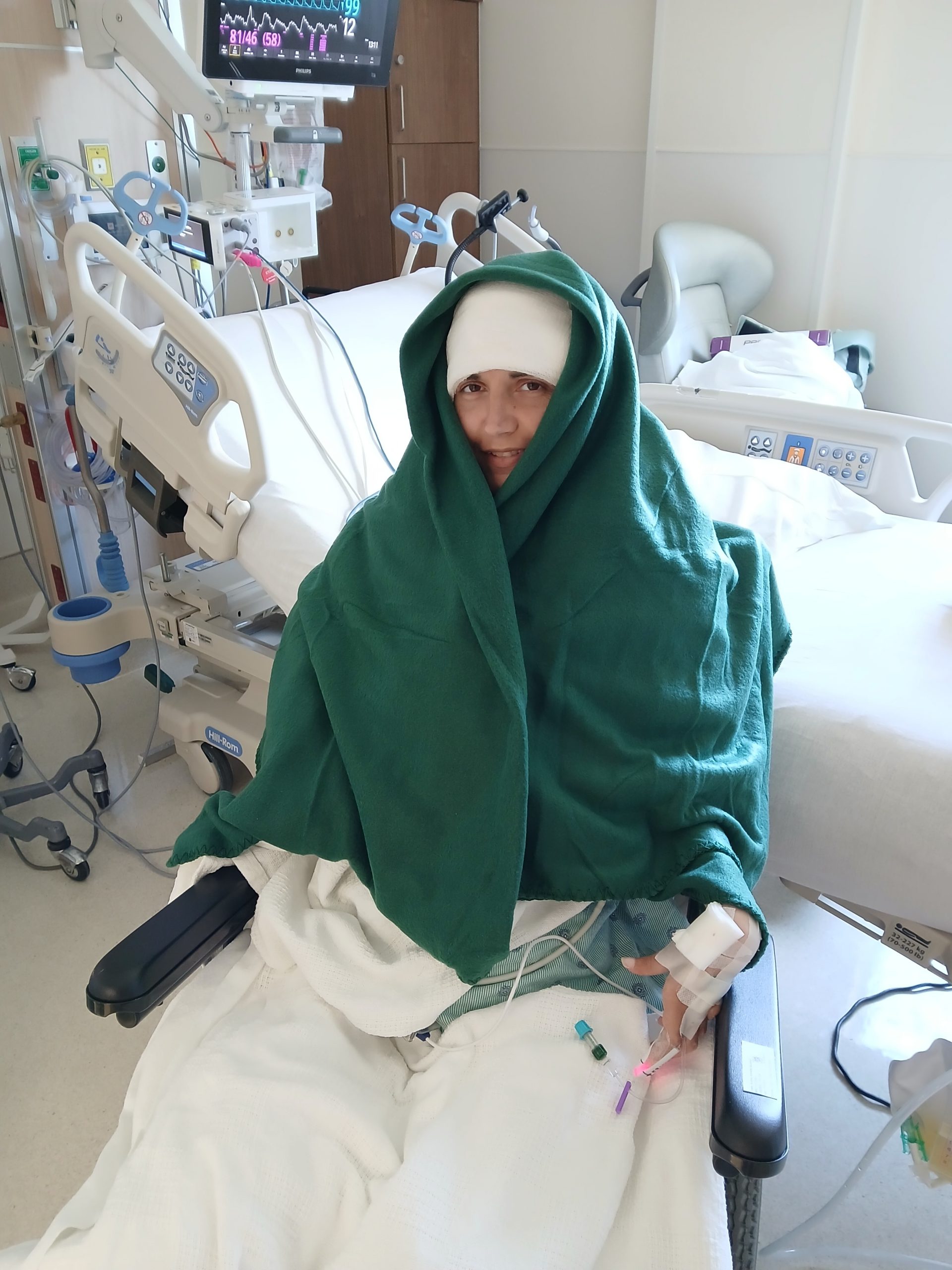
Leave a Reply